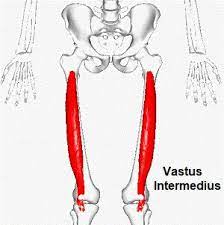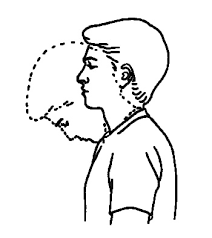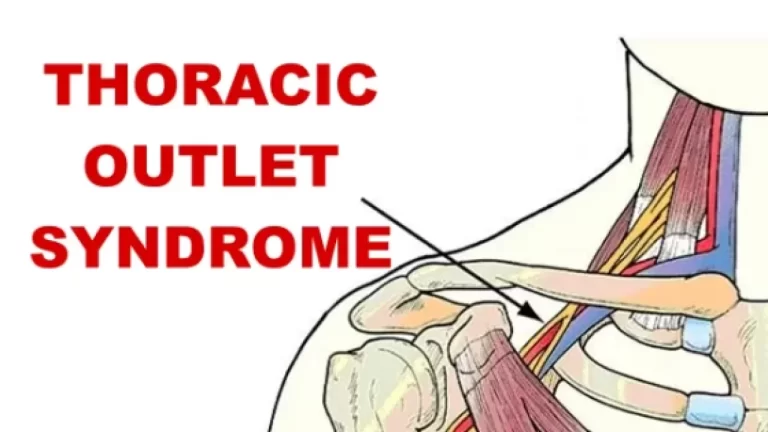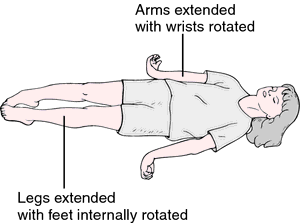34 Best Exercise for Trapezius
Exercise for Trapezius is a great way to make your upper back powerful & flexible, this exercise has many health benefits and also reduces the risk of injury.
The trapezius muscle is located in the upper back and neck region and is responsible for several important movements, including shoulder elevation, retraction, and depression.
Table of Contents
What is a Trapezius muscle-strengthening exercise?
The trapezius muscle is a large muscle and it is shaped like a trapezoid. The trapezius is separated into three parts: the upper part, middle part, & lower part. This muscle movement allows for the head, shoulder, & neck activities, twisting the trunk, standing upright position, & lifting and using the arms. It is because they have heavily acted their trapezius, a large, stingray-shaped muscle. The Trapezius muscle arises from right below the skull runs down the neck & across the shoulders & then continues down the spine in a “V” shape.
This muscle functions to stabilize the shoulders & upper back. Maintain proper posture & avoid back pain, it is crucial to keep the trapezius strong. The upper trapezius supports the arms & elevates the shoulder blades, while the middle & lower trapezius is important for scapular retraction, depression, & rotation. Shrug the shoulders, and lift the arms, so teaching them to be as strong as they can be will help them out in more than only the big back division. Add these activities to the upper body workout to start building bigger, stronger trapezius.
Health benefits of trapezius exercise:
- It helps to enhance the strength of the shoulder
- It helps to boost the neck muscles
- It helps to strengthen the back muscles.
- It helps to enhance the posture.
- It helps to stabilize the neck
- It helps to stabilize the upper back
- It helps to reduce the strain on the neck & shoulder muscles
- It helps to decrease chronic neck pain
- It helps to move the scapula free.
- It helps them to carry objects overhead.
Here are 34 Best exercises that can help strengthen and tone the Trapezius muscle:
Corner Pec Stretch
Forward-rounded shoulders are a big offender of strain on the cervical muscles. The pectoral muscles across the chest can become tight after slumping for extended periods. Taking a break during the day to complete a corner pec stretch will bring some of the strain off of the neck. The patient’s starting position is standing upright, positioning himself to encounter a doorway or a corner. Put the forearms flat on the door frame or wall, with the elbows at shoulder height, then slowly bend forward until feeling a light stretch in the front of the shoulders. You can also take a small step forward if required. Maintain this exercise position for 15 to 30 seconds and repeat this 3-5 times every day.

Chin Tuck
Another part of posture & the forward rounded head part is that the upper neck, or craniovertebral spine, is moved into extension. To control this position, re-education of the deep cervical flexor muscles is important. The patient’s position is to lay on the back, tuck the chin toward the chest, & imagine an axis via the ears. Try not to utilize the sternocleidomastoid muscle on the neck side, and maintain the tuck for 5 to 10 seconds. Do 3 sets of 10 repetitions.
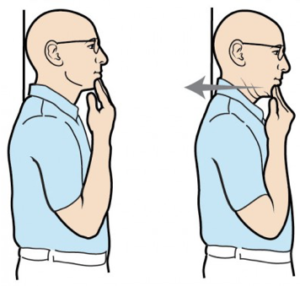
Upper trapezius stretch
Seating at a computer for longer than 30 minutes can lead to tightness & trigger points in the upper trapezius muscle. Taking a break for an upper trap stretch can be useful to prevent headaches. It may be useful to set an alarm throughout the day to stop & perform this stretch. This is one of the easiest trapezius exercises for pain, & it works by creating a stretch via the neck & across the upper trapezius. In this exercise, the patient’s position is to put the left hand on the right side of the head. Then use gentle pressure, pulling the head towards the shoulder. Maintain this exercise for 30 seconds & then switch to the opposite side. Repeat this 3 to 5 times on both sides every day.
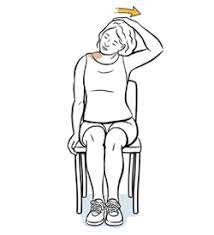
Lower Trap Lift Off
This exercise is useful to re-educate the mid-back muscles, especially the lower trapezius. This exercise will also reduce a little bit thoracic extension. In this exercise, the patient starts with arms overhead on the wall in a Y position. Ensure that hunch the shoulders. Then lift the arms away from the wall and stay within a range of motion where you feel relaxed. After then slowly back arms to the wall. Extra benefit if you can keep a slight chin tuck. Do this exercise for 3 sets of 10 repetitions every day.
Foam Roller: Thoracic Extension
This stretch of mobilization exercise is helpful to get out of the rounded shoulders position. While sitting in a declined position, the thoracic spine sits in flexion. This position permits reinforcing thoracic extension. Sometimes feel a couple of pops, those are joints clicking back into place. The patient’s position is lying down with the foam roller beneath the upper back. Then maintains the head to support the neck muscles, and rolls up & down the thoracic spine. ensure that you are not holding your breath during the exercise, and repeat this exercise 10 to 15 times every day.
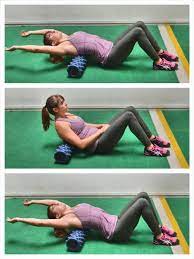
Ear to shoulder
The patient’s starting position is sitting or standing, but as part of this succession, sitting on the ground, on a mat, is advised. Then slowly & with ease, take the right ear toward the right shoulder. It’s natural for the left shoulder to lift as you do this. Ease the head back toward the center until you can rest the left shoulder back down. After then raise the right hand up & over the head, resting the hand on the left cheekbone. try to do not to pull on the head now, though. Just rest the hand there for just a little more pressure. This very gently stretches the upper trapezius. Do this exercise for 15 to 30 seconds, and then gently remove this side, & then ease the left ear toward the left shoulder & meet the stretch on another side, trying to breathe powerfully through it.
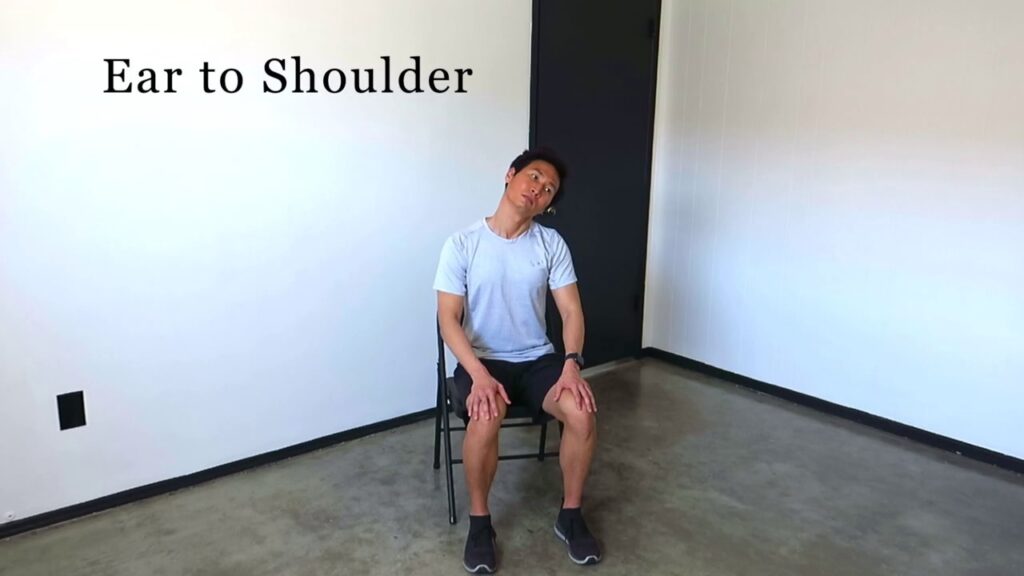
Crocodile pose (Makarasana)
This activity can be painful at first. Feels weird to relax facedown, but if they breathe slowly & this can help reduce the trapezius. The patient’s position is to lie down on the stomach with the feet shoulder-width apart and rest the hands one on top of the other under the chin. When you’re in place, lie flat & rest the forehead on the stacked hands. This will release lower back compression as well, but the primary thing they want to visualize & focus on here is lengthening the spine & releasing any tension in the upper back & neck. During exercise breathe deeply & try to relax.
Cobra pose (Bhujangasana)
This exercise releases tension in the lower neck & trapezius and stretches the throat. It also increases flexibility in the spine & strengthens the back and arms, allowing prevent future trapezius issues. In this exercise raise your head & place your hands on the ground next to your shoulders, keeping the arms parallel & the elbows close to the body. After then press the tops of the feet into the ground & inhale deeply as you begin to lift the head & chest. Whether you raise straight arms or not, keep in mind that you want the neck & head mean cervical spine to be on the same curve. Try to raise the head as well, but they want to simply ease it up. Try to chin very common to extend the chin out in this position & let the shoulders creep up toward the ears, so take a point to roll the shoulders back & down, pulling the shoulder blades closer together as you pull the torso via the upper arms, & relax your chin back. Then maintain this for a few breaths & release on an exhale. Inhale as they lift into this pose at least 2 more times, holding it for a little bit longer each time.
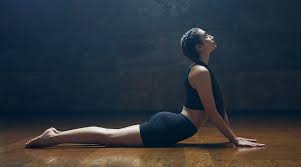
Cat-Cow pose (Marjaryasana-Bitilasana)
This exercise relieves tension in the cervical spine & stretches the back muscles as well as the front of the torso. When doing this exercise, especially for the trapezius, try to focus on the place right between the upper shoulder blades, alternately arching & releasing the neck. In this exercise push up onto all fours, into a tabletop position, and your hips should be directly over the knees, the shoulders over the elbows, and the elbows over the wrists. During inhale, lift the head, chest, & sitting bones, letting the belly sink, & arching the back. During exhale, round the spine toward the sky & release the head into the cat posture.
Continue taking deep breaths, moving with the breath as you do, inhaling as you arch the back & exhaling as you round the back.
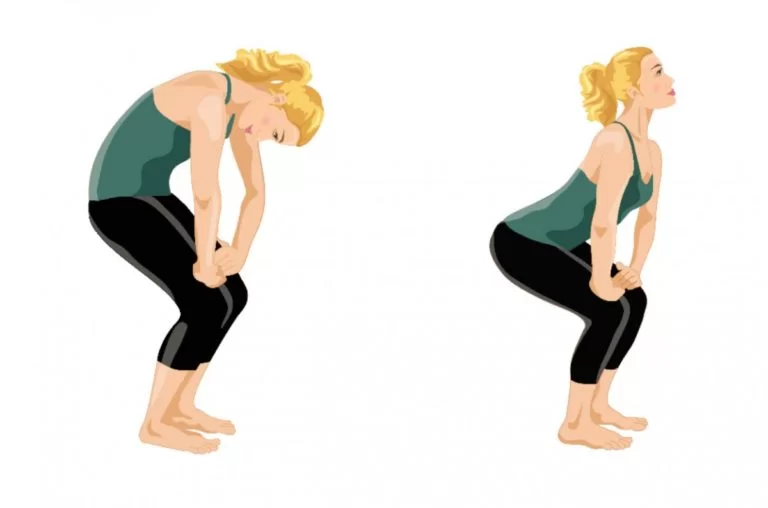
Trapezius Stretch
The patient’s position is to sit up tall with good posture holding shoulders down and grasping the bottom of the seat with one hand. Then slightly turn the ear to the shoulder until a comfortable stretch is felt on the other side of the neck. Maintain this position for 15 to 20 seconds, and repeat to each side 3 times. Perform this exercise 2 times every day.
Levator Scapular Stretch
The patient’s position is to sit up tall with the right posture keeping shoulders down and grasping the bottom of the seat with one hand. After then slightly turn the chin toward the armpit until a relaxing stretch is felt on the other side of the neck. Maintain this position for 15 to 20 seconds, & repeat to both sides 3 times. perform this exercise 2 times every day.

Neck Rotation
In this exercise rotate the head gently & slowly from side to side. Try to do not to turn the head completely to either side and keep the movement small. Keep chin level with the floor without letting the chin drop to the chest. Repeat this exercise 10 times, and do this exercise 2 times every day.

Theraband Rows
In this exercise place theraband around a doorknob, or tie a knot in the band & close it in the door. Set the band at chest level. The patient stands with both ends of theraband in the hands, knees slightly bent, and abdominal muscles tight. Holding tight trunk muscles, pulling arms back while squeezing shoulder edges together. Concentrate on squeezing the shoulder blades without shrugging the shoulders up towards the ears, and back to starting position. Try to do not to bend back. Repeat this exercise 20 times and do it 2 times every day.
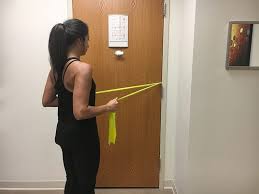
Prone Rows
The patient’s position is to lie on the stomach with the arms slumping off the side of the bed and try angling. Beneath the stomach use a pillow for comfort. Then begin by pulling arms back while tilting elbows & squeezing shoulder blades together then slowly back to starting position. Perform not to lift the head while pulling the arms back. Repeat the exercise 20 times and do it 2 times every day. There have various types of strengthening exercises for the trapezius muscles.
Shoulder blade squeeze
For this exercise, the patient’s position is to stand with good posture, slowly squeeze the shoulder blades together & hold for 3 to 5 seconds. After that slowly release the shoulder blades back to their normal positions This exercise can also be done with a resistance band, utilizing cables, or maintaining the arms out front in a goal standing position. Perform this exercise 5 to 10 times every day.
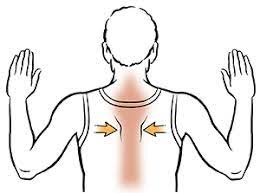
Shrug
This exercise is another exercise to keep the trapezius strong. The shrug is very common & easy to implement, & it is one of the great exercises to start the trapezius. Perform this exercise with weights like dumbbells in your hands. For this exercise, you have to stand straight with the right posture. Lift the shoulder joint as high as you can get them towards the ears with the shoulders. Release and then back into the starting positions. Repeat 20 to 30 times every day.
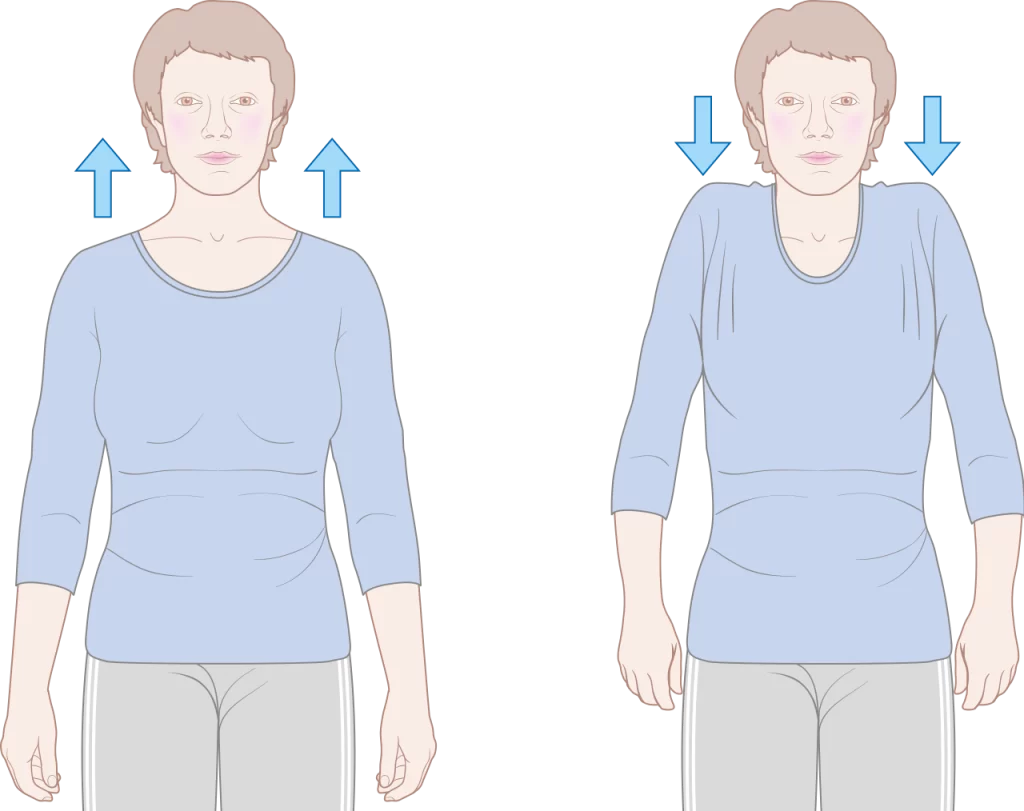
Upright row
This exercise strengthens the trapezius muscle. For this exercise, the patient’s position is to stand straight. With the fists clenched, pull up the fists as high as you can while flexing the elbows, the hands should be close to the front of the body. Maintain a count of 2 to 4 times. Release the arms and return to the starting position, fists still gripped, and repeat this exercise 15 to 30 times every day.
Pushup
There have many various variations of the pushup. Do this version that is easiest, a pushup while kneeling on the floor, or a standing pushup against a wall. Place the hands flat on the floor or the wall. Lower the body toward the hands while keeping the back straight and the stomach tight. Don’t let the head drop the neck should be in line with the rest of the spine. Lower the body until you are close to the floor or the wall, & then push back into an upright position. Breathe in as they go down & breathe out as you push up. The key to the pushup is to focus on pushing the shoulders together during the exercise. Make the middle & lower trapezius work to accomplish their work. Perform 10 to 12 repetitions per workout.
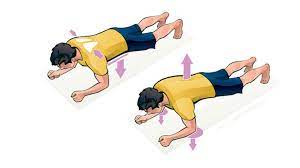
Farmer’s Carry
For this exercise, the have to grab weight dumbbells or kettlebells will do in both hands by your sides and stand straight. Engage the core & back muscles, holding a strong, upright posture. Then walk forward holding a weight in your hands. Perform this exercise for 25-35 seconds of 2 to 3 sets every day.
Cable Face Pull
In this exercise bring the face in on the movement with this underrated trapezius move. This exercise can be done with a cable machine or even with an opposition band if they are concentrated on mastering the form to help bulletproof the back & shoulders. The face pull switches the lower trapezius when done right. For this exercise, the patient’s position is set to the cable machine or resistance band approx at eye-level height. Maintain the cable rope handles or the ends of the band in both hands in an underhand grip. Squeeze the shoulder blades to pull toward the face, the elbows should be high & resist the urge to bend forward. Then pause to squeeze once the pull back as far as you can, then control the cable and then return to the starting position. Perform this exercise for 10 to 15 repetitions for 2 to 3 sets every day.
Dumbbell Military Press
This exercise is for standard shoulder builders but will nail the trapezius, too. Performing with dumbbells allows them to work in more shoulder in safe positions, mainly because you will be less inclined to try to raise more weight than you can handle by stacking plates on a barbell. Hold a pair of dumbbells in your hands & raise them to the shoulders. Then brace your core & glutes to set a firm foundation the biggest. The mistake you want to avoid is rounding the back under the weight. keep the ribs extending. Once you are ready to press, make sure that you are not raising straight up. Move in the scapular plane about a few degrees in front of the trunk to keep the rotator cuffs safe so rotate the elbows out negligibly. Contract the shoulder blades, then press the weight up, and perform this exercise 10 to 20 repetitions for 2 to 3 sets every day.
Dumbbell Snatch
In this exercise, you will get the entire body engaged to do the dumbbell snatch right, particularly as you get the dumbbell up above the head. Start with the dumbbell on the ground in front of the between the legs with the ur feet wider than shoulder-width apart. Flex at the knees & hinge at the hips & hold the dumbbell in an overhand grip. After then sit backward on the heels, then explode up to stand, and drive the weight up close to the body. Pull the significance weight up as if you are zipping a coat. Pull slightly back & land underneath the weight overhead. Lower the weight to the shoulder slowly to complete the movement. Perform this exercise with 10 to 15 repetitions for 2 to 4 sets every day.
Bent Over Y
This is a very simple exercise. For this exercise, the patient’s position is to stand with the feet shoulder-width apart & grab light dumbbells with the thumbs facing up. After that hinge at the hip to get a bent-over position, & promote the arms in front of the building in the form of the letter Y, maintaining the position for a point, and then back to the starting position Perform this exercise with 10 to 12 repetitions for 2 to 3 sets every day.

Pull up Shrug
This exercise not only builds the trapezius but will also help hone your pull-up form. You will also work the lattisimus dorsi, so you do not separate one muscle. Then you have to hang from a pull-up bar, the spine should be aligned & core muscles tight. The shoulders should be pulled back & down to extend the head & neck upward. Maintain for a 2 count, and then lower yourself back into the starting position. Perform this exercise with 12 to 15 repetitions for 2 to 3 sets every day.
Barbell Shrug
This exercise targets the upper head of the trapezius, which is responsible for expanding the shoulder blades, and this exercise is the king of all the exercises. Grab a barbell with an overhand grip that is just outside shoulder-width apart, & let the barbell swing at arm’s length in front of the waist. The back should be inherently arched, and bend forward at the hip about 10 to 15 degrees. After then bent your knees slightly, and then shrug the shoulders toward the ears as high as you can. The arms should be extended. After then do the same movement back to the starting position. Perform this exercise with 10 to 15 repetitions for 2 to 3 sets every day.
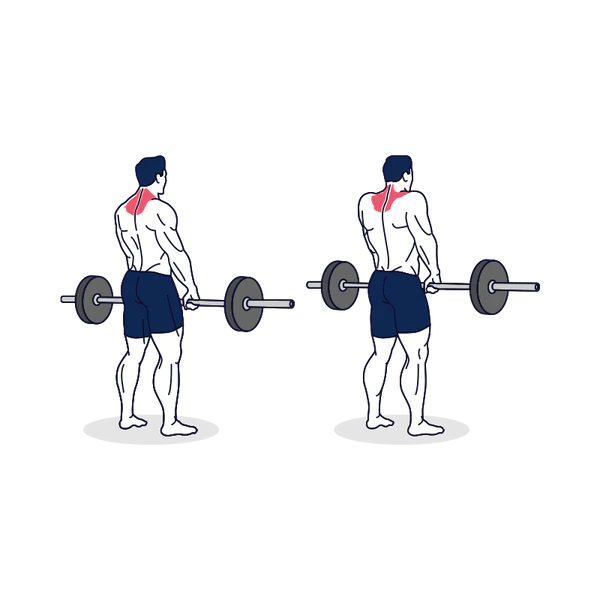
Rack Pull
For this exercise, the patient’s position is to set up a rack or boxes so the bar is elevated above the shins. Keep the barbell around shoulder-width with an overhand grip, hinge from the waist & push the hips back & feet via the ground, and pull the barbell up & the back should be straight. Pause at that point for 2 to 3 seconds, then control the barbell back down into the starting position. Perform this exercise 10 to 18 repetitions for 2 to 3 sets every day.
Dumbbell or Kettlebell Shrug
This exercise corresponded to the barbell shrug, the dumbbell or kettlebell shrug put less pressure on the shoulder joints. That is because the shoulders do not have to rotate to maintain a barbell. This maintains them more stable as you do the exercise. For this exercise, you have to stand shoulder-feet width apart & hold a pair of dumbbells or kettlebells in your hands. Hang at arm’s length by the sides, the palms confronting each other, then shrug the shoulders towards the ear as high as potential by you. Pause in the up position for 5 seconds, then gradually lower the weights back to the initial position. Perform this exercise with 15 to 25 repetitions for 2 to 3 sets every day.
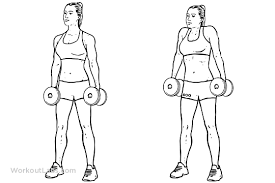
Incline Dumbbell Shrug
This variation exercise of shrug targets the lower trapezius, and then the lower trapezius position is pulling the shoulder blades down. For this exercise, need a low-incline bench. Grab a pair of dumbbells in both hands & lie chest down at 45 to 50 degrees on the bench. Then the arms should be hanging directly down, with both hands facing each other, and by pulling the shoulder blades jointly shrug the shoulders. Maintain this exercise for 5 to 8 seconds then slowly lower it down to the starting position. Perform this exercise with 10 to 15 repetitions for 2 to 3 sets every day.
Dumbbell Jump Shrug
The incendiary movement adds power to the daily workout. The main goal should be to do each repetition as quickly as possible while maintaining control of the weight at every time. Grab a pair of dumbbells in both hands & flex the hips & knees. Allow the dumbbell to hang at arm’s length slightly below the knees. The hands facing the sides try to not round the lower back. Simultaneously push the hips forward, shrug the shoulders strongly, & jump as much as you can. After that and as softly as possible, repeat. perform this exerciser for 10 to 15 repetitions every day.
Dumbbell Lateral Raise
In this exercise hold a pair of dumbbells & let them hang by the side. The patient’s position is to stand tall, with the feet- shoulder-width apart, and move the arms so that the palms are facing forward, & flex the elbows slightly. Without altering the bend in the elbows, elevate the arms to the sides & slightly in front of the trunk in the scapular plane, place until they are at shoulder level. The arms reach near to parallel with the ground and rotate the thumbs slightly upwards towards the top. Blasing the shoulders into external rotation by doing this, is safer for the rotator cuff muscle. The arms should create a T with the body, and pause for 2 seconds at the top of the movement, then slowly lower the dumbbell back to the starting position. Perform this exercise for 20 to 25 repetitions for 2 to 3 sets every day.
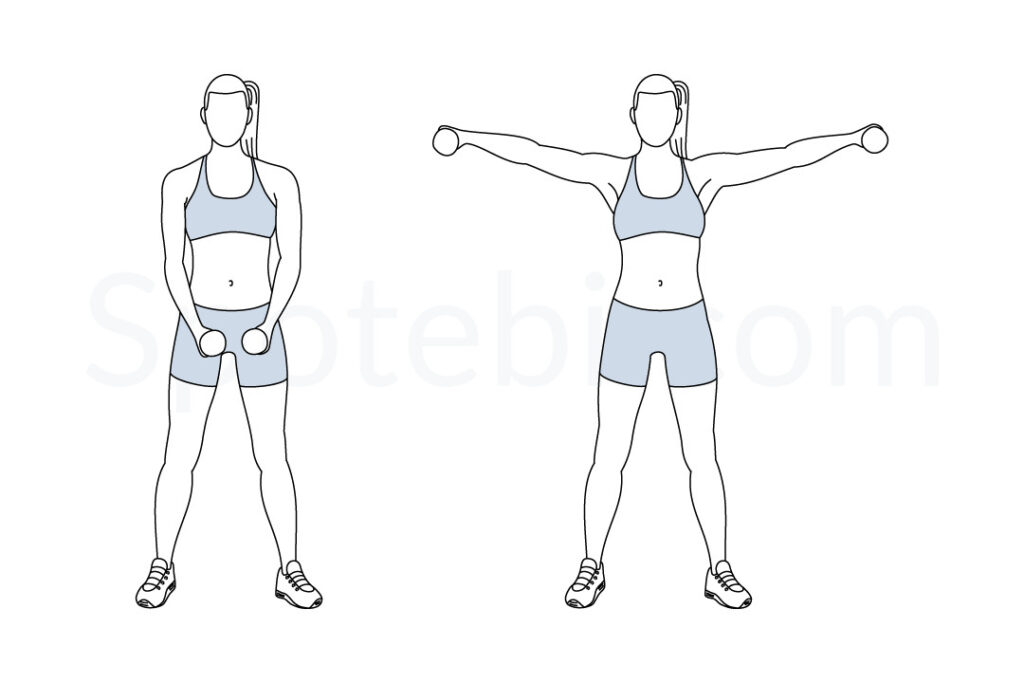
Overhead Barbell Shrug
For this exercise holding the barbell above the head as you shrug utilize the upper trapezius. It also lowers the stress on the levator scapulae the rope-like muscle that travels down the back of the neck. For this exercise, you have to stand shoulder-feet width apart & load the barbell with a low weight. After then grab the barbell with a wide overhand hold the arms should be raised & lock the elbows, now shrug the shoulders towards the ear. Maintain that motion for a couple of seconds then slowly return to the starting position. Perform this exercise with 6 to 10 repetitions for 2 to 3 sets every day.
Snatch-Grip Barbell High Pull
This exercise is a fast power activity that relies on the trapezius, mid-back, rhomboids, deltoids, hamstrings, glutes & lowers back to move the weight. For this exercise, the patient’s position is to stand shoulder-feet width apart & pack the barbell with a low weight. After then grab the barbell with a wide overhand grip & let it hang at arm’s length in front of the body. The hands should be a few inches from the weight plates and then flexed from the hips & knees to squat down. Keep the lower back inherently arched, and pull the barbell as high as you can by explosively standing up as bend the elbows & raise the upper arms. You should rise on the toes, and reverse the motion to back to the starting position. Perform this exercise with 12 to 16 repetitions for 2 to 3 sets every day.
Dumbbell Overhead Carry
If the lower body is moving, the upper body is also performing an isometric hold. Increasing the trapezius time under tension stimulates muscle growth. For this exercise, the patient’s position is to stand with shoulder-feet width apart & hold a pair of dumbbells & press them over the head, keeping the palms facing each other. The upper arms should be successive to the ears, withholding dumbbells overhead you have to walk forward. Perform this exercise with 12 to 15 repetitions for 2 to 3 sets every day.
Scaption
This exercise primarily hits the anterior deltoids, rotator cuff, & serratus anterior, the lower trapezius & rhomboids also aid in lifting the weight. This exercise benefits to balance the muscles that rotate the shoulder blades. Counting this exercise into the upper-body routine will help build stronger, healthier shoulders & a better posture. For this exercise, the patient’s position is to stand with the feet shoulder-width apart & grab a pair of dumbbells at arm’s length following to the sides. The palms should be facing each other & the elbows slightly flexed and stand as tall as you can. Without altering the bend in the elbows, elevate the arms up to a 30-degree angle to the body so that they form a Y until they are at shoulder level. Pause for some seconds and then gradually lower the dumbbells and return to the starting position. Perform this exercise with 8 to 15 repetitions for 2 to 3 sets every day.
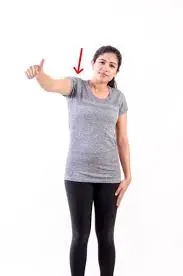
Safety and precautions
Never do trapezius workouts without knowing their proper method from a professional trainer or a physiotherapist. This will help them to avoid damage & soreness of muscle.
Give the muscle to reasonable targets & never try to accomplish too much fast. Start with slows & builds upon the sets & repetitions.
Listen to the body, and if have felt pain during exercise, stop doing instantly & consult the therapist or trainer.
Start a trapezius workout fitness program only after discussing it with the therapist. This is particularly important for people who have some past health problems or are on some comorbidity.
Always do trapezius stretching exercises before & after the strength workout. This will help to improve circulation & warms the muscles before a trapezius muscles workout.
Even the best trapezius exercises would not work if you do not use the tools properly. This will prevent strains & damage.
When did you not do this exercise?
If already suffering from neck & shoulder pain then avoid this exercise.
If the healthcare provider is recommended to take a rest.
If feel any neck or shoulder pain during this exercise then stop instantly.
If suffering from back pain then avoid weight-lifting exercise.
If the arm bone is fractured newly.
If recently feel any cervical issues.
FAQ
To work out the trapezius muscle, it’s essential to target the muscles with exercises that permit a full range of motion [ROM], like shrugs, along with isometric exercises where the traps are stabilizing, such as the deadlift. which is one of the best blend exercises.
Getting traps growing, require two things: heavier weight & more volume. Both should be had every week that train. Want to hit the trap’s muscle strongly with as much weight as possible, upholding repetition of almost 6 to 8 with some sets.
To get the best results, it’s necessary to neither underwork nor over-work the traps. For most people, 2 trap workouts per week are the ideal amount. Each trap-concentrated session should last roughly 20-30 minutes. Rest the muscle for 3 days between sessions.
The trapezius muscle is mostly a perseverance muscle if you think about it, it has to hold up the weight of your arms all day long and thus would respond better to a higher repetition workout. Suggesting it takes a lot of repetition to get it to rise.
If you can turn them sufficiently to turn the movement into a dumbbell raise, it’s an expression that you require heavier weights. I suggest exercise traps twice per week.
Training the traps muscle with only shrugs makes as much sense as training the shoulders with only lateral raises. Nobody does that because it’ll set them up for joint damage, limited strength gains, & incomplete muscle growth.
The tightness of the trapezius muscles involves many people in different situations. Maybe you have been doing too many overhead movements like swimming or playing tennis. Might have had heavy objects or been sitting in one position for a long period.



